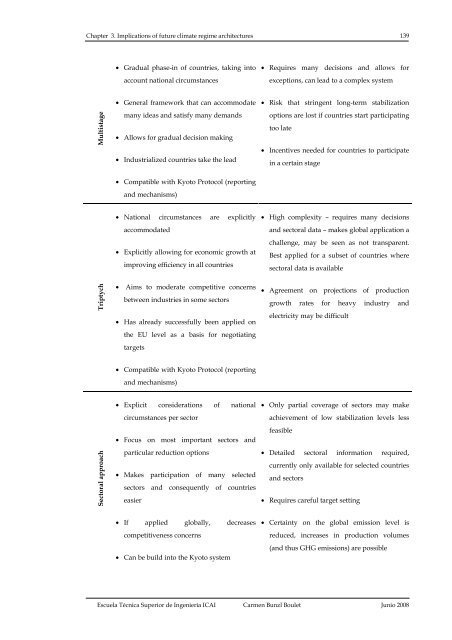Carmen Bunzl - Universidad Pontificia Comillas
Carmen Bunzl - Universidad Pontificia Comillas
Carmen Bunzl - Universidad Pontificia Comillas
Create successful ePaper yourself
Turn your PDF publications into a flip-book with our unique Google optimized e-Paper software.
Chapter 3. Implications of future climate regime architectures 139<br />
Multistage<br />
Triptych<br />
Sectoral approach<br />
• Gradual phase-in of countries, taking into<br />
account national circumstances<br />
• General framework that can accommodate<br />
many ideas and satisfy many demands<br />
• Allows for gradual decision making<br />
• Industrialized countries take the lead<br />
• Compatible with Kyoto Protocol (reporting<br />
and mechanisms)<br />
• National circumstances are explicitly<br />
accommodated<br />
• Explicitly allowing for economic growth at<br />
improving efficiency in all countries<br />
• Aims to moderate competitive concerns<br />
between industries in some sectors<br />
• Has already successfully been applied on<br />
the EU level as a basis for negotiating<br />
targets<br />
• Compatible with Kyoto Protocol (reporting<br />
and mechanisms)<br />
• Explicit considerations of national<br />
circumstances per sector<br />
• Focus on most important sectors and<br />
particular reduction options<br />
• Makes participation of many selected<br />
sectors and consequently of countries<br />
easier<br />
• If applied globally, decreases<br />
competitiveness concerns<br />
• Can be build into the Kyoto system<br />
• Requires many decisions and allows for<br />
exceptions, can lead to a complex system<br />
• Risk that stringent long-term stabilization<br />
options are lost if countries start participating<br />
too late<br />
• Incentives needed for countries to participate<br />
in a certain stage<br />
• High complexity – requires many decisions<br />
and sectoral data – makes global application a<br />
challenge, may be seen as not transparent.<br />
Best applied for a subset of countries where<br />
sectoral data is available<br />
• Agreement on projections of production<br />
growth rates for heavy industry and<br />
electricity may be difficult<br />
• Only partial coverage of sectors may make<br />
achievement of low stabilization levels less<br />
feasible<br />
• Detailed sectoral information required,<br />
currently only available for selected countries<br />
and sectors<br />
• Requires careful target setting<br />
• Certainty on the global emission level is<br />
reduced, increases in production volumes<br />
(and thus GHG emissions) are possible<br />
Escuela Técnica Superior de Ingeniería ICAI <strong>Carmen</strong> <strong>Bunzl</strong> Boulet Junio 2008

















